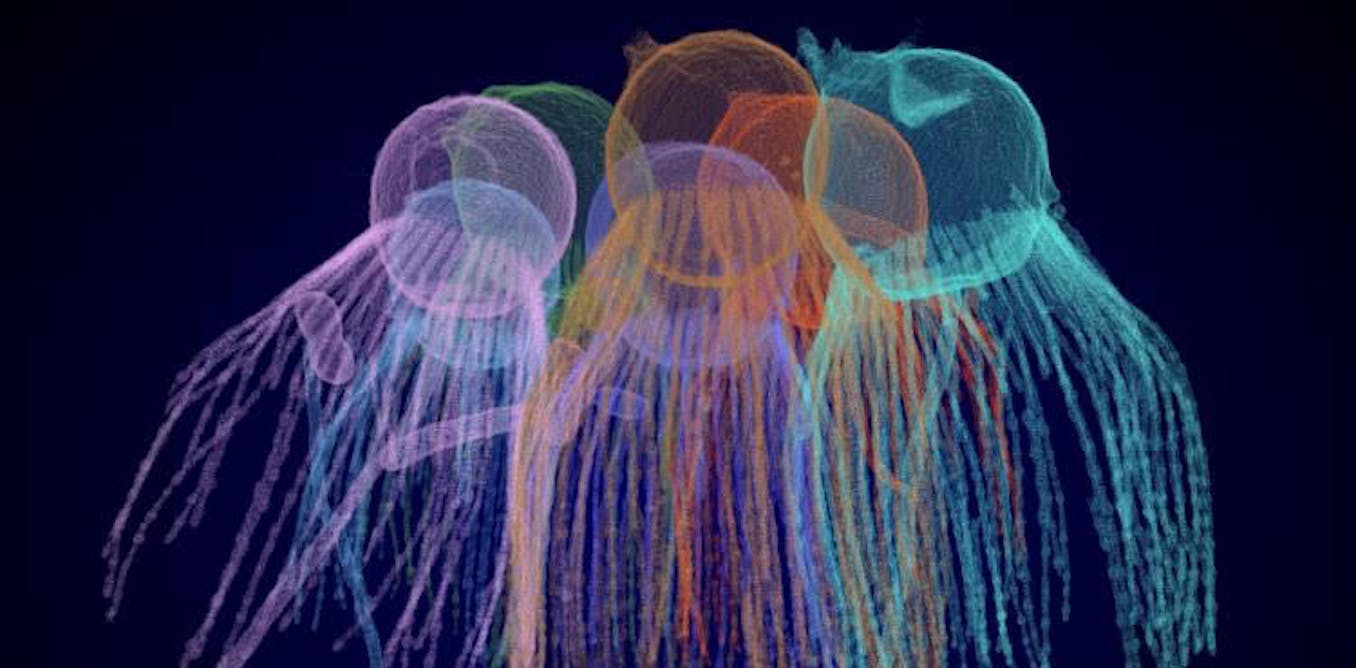Once upon a time, a flatworm’s head exploded in a Petri dish — not an especially uncommon occurrence in biological research. But what happened next mystified developmental biologist Michael Levin, who runs the Allen Discovery Lab at Tufts University in Medford, Massachusetts.
The flatworms, called planaria, had been swimming in a solution of barium chloride, a nasty chemical they had never encountered before in their 500 million years of evolution. A few clogged potassium channels later and the planaria’s cells began to degenerate.
“Their heads literally explode overnight,” Levin tells Big Think. Several weeks later, their heads had regrown, which isn’t itself unusual: Planaria have highly regenerative capacities, regrowing into fully intact organisms after being cut into hundreds of pieces. They are frequently studied by biologists for this reason. But what Levin’s team did not expect was that, after regrowing a new head, the planaria were no longer intolerant to barium chloride, suggesting they’d modified the expression of their genes to adapt to the new environment.
“There is no reason why they should have a built-in mechanism for expressing certain genes when they encounter barium; this is a completely novel problem for them,” Levin says, noting that the worms somehow self-selected the right smattering of genes to modulate out of an entire genome. “We don’t know how this works. It’s very interesting to think about how this works.”
The research hints at a larger idea: Biological systems don’t just passively follow genetic instructions — they adapt. Cells seem to “figure out” solutions to new problems, sometimes in ways scientists can’t yet explain.
What if medicine could harness this innate healing ability with precision, using technology to direct the body to repair damaged tissues and organs, or even regenerate them entirely?
That’s the fundamental question driving regenerative medicine. About to enter its golden age, the field is coinciding with exciting developments in biology, computational neuroscience, and artificial intelligence to usher in what Tufts University Professor Michael Levin calls a kind of “somatic psychiatry” — and it may just be the future of medicine.
Regenerative medicine
Regenerative medicine involves replacing or regenerating cells and tissues damaged by injury or disease, often by stimulating the body’s own reparative capacity. The poster child of regenerative medicine is arguably stem cell therapy, where self-renewing cells found naturally throughout the body are repurposed as other cell types to repair damaged tissue. These cells, which can be grown in a lab, can generate new specialized cell types. For example, stem cells found in bone marrow can be coaxed into becoming healthy blood cells. Other stem cells can become bone cells, heart muscle cells, or brain cells. When harnessed to maintain or repair tissue, both adult and embryonic stem cells can help scientists understand and treat disease. Stem cell therapies have already shown success in treating leukemia, lymphoma, neuroblastoma, and multiple myeloma in this way.
But regenerative medicine is more than stem cell therapy. Technologies like 3D bioprinting, growth factor therapy, tissue engineering with biomaterials, and nanotechnology can help scientists stimulate the body’s healing capacity.
The field has ventured into uncharted territory with the rise of bioelectric medicine, which focuses on signaling between cells rather than manipulating cells directly. Researchers have found that rather than focusing on the “hardware” of cells themselves, they can reach even greater regenerative goals by leveraging the “software” of how cells communicate, in some cases regenerating entire animal body parts through electrical signaling. Importantly, this works not because scientists tell the body how to regenerate, as is the case with stem cell therapy; they only tell it what to grow and where. The body takes care of the rest on its own.
In Levin’s lab, research on planaria and other organisms has inspired the team to think differently about how biological systems find creative solutions to problems, and whether humans might have similar, but as of yet untapped, innate capacities. Although most of their work has been in animal models, they’ve made some tantalizing discoveries about regeneration that may someday apply to humans.
Take the frog tadpole. In one study, after engineering a tadpole specimen without eyes in its head, the team inserted a series of eye precursor cells into its tail and the tadpole grew a functional eye on its tail, which connected to its spinal cord and supported the organism in navigating its environment despite not being connected to its brain.
“You didn’t need thousands of generations for this to evolve,” Levin stresses, noting that it’s more about the innate plasticity of the organism. “Its architecture is already ready to be scrambled in this way and still have adaptive function, and that has huge implications for evolution.”
Levin’s team is working on harnessing that innate plasticity to find solutions for a range of diseases, including birth defects, traumatic injury, cancer, and aging.
“As workers in regenerative medicine, we’d like to know, if a part is missing, how do we recreate it?” Levin says. “As engineers, we want to go further and say, can we push these cells to do something other than what they normally do — can they build something completely different?”
Levin says biomedical science has been fixated on the “hardware” of life — gene editing, CRISPR, and molecular pathways — while largely overlooking the “software”: the bioelectric networks that govern how cells communicate, coordinate, and make decisions.
The endgame he envisions is a platform that interacts with these networks, sending signals that instruct cells to heal, regenerate, and adapt. Rather than manually rewiring genes or engineering tissues, users would input a desired outcome — regenerating a limb, reversing cancer, or prompting the body to form new biological structures — and the system would translate it into bioelectric cues that guide cells to achieve that goal.
“We’d feed in the signals. It would do the work. It’s a communications device, not a 3D printer. The cells do the building.”
Collective intelligence of the body
When or whether scientists will create such a platform remains an open question; scientists still don’t fully understand the complex bioelectric language that cells use to communicate, coordinate, and make decisions. But one reason that bioelectric networks hold promise for treating disease is because they are exactly that: networks. It is easy to overlook the fact that “everything is connected” within the human body, but that’s precisely the point — when things become disconnected, trouble tends to arise.
In another experiment, Levin’s team showed that when human oncogenes (tumor genes) were injected into a tadpole, they produced tumors. However, when researchers changed the polarization of particular ion channels within the tadpole and those tumor-producing cells were guided into an electrical state of communication with neighboring cells, the chance of tumor development was significantly reduced despite the strong expression of the oncogene.
Along these lines, Levin calls cancer “a disorder of collective intelligence,” meaning it occurs when cells disconnect from the goals of the larger electrical network of which they are a part. “When they disconnect, they can no longer remember this giant thing they’re working on.” The cells are not more “selfish” than normal cells — they just have smaller selves. This “dissociative identity disorder” leads them to pursue single-cell goals, which quickly get out of hand. Using diagnostics based on a bioelectric signature, future regenerative scientists may be able to detect cells that are about to disconnect from the network and intervene before it’s too late.
“What if we reconnected these cells with their neighbors — not killed them with toxic chemotherapy, just reconnected them?”
In a way, the approach is more similar to behavior science than biology. Levin compares modern molecular medicine to a mechanical clock, where researchers are focused on “rewiring the hardware.” The assumption, he says, is that tissues and cells are like parts of a clock that need to be manually wired or rewired in a certain way. But what if medicine is more like classical conditioning, or even psychoanalysis?
“You can change the goals and behaviors of a complex organism just by interacting with it, even once,” Levin says. “You can say to a human, ‘You really should go to grad school’ and they say, ‘Yeah, you’re right’ and then it’s ten years of effort because you said this one thing. You didn’t manually wire all of the possible outcomes of going or not going to grad school and manually set things into motion, or reward or punish them for it; their brains did all of the hypothetical work.”
The assumption that cells and tissues are low-agency things like mechanical clocks, Levin says, has been proven false. Instead, living tissues are what he calls “agential materials”: They have agendas, learning capacities, and memory. The real advances in regenerative medicine, he says, are going to be had by people who make use of this in a way that looks a little like what he calls somatic psychiatry.
“They’ll need to ask, of cells, things like, ‘What did you learn in your last seven weeks of being a cell that is going to modify how you react to the drug I’m going to give you? Do you believe you’re in a safe environment? How do I get you to believe you’re in a safe environment, because you seem to be under stress all the time and you don’t need to be. You seem to be overthinking your lack of safety here.’”
Of course, researchers haven’t observed language or forward planning in cells, he says, but they have seen forms of memory, learning, decision-making, valence, preferences, and other traits that come from behavior science, not chemistry.
“If you go to any alternative healthcare practitioner, they’ll say to you [things like], ‘The body remembers’ and ‘the wisdom of your cells,’” Levin notes. “They’ve been saying that for thousands of years. What we’ve done — which is consistent with a lot of that stuff — is to take very specific ideas from cognitive and computational neuroscience and to pivot them to non-neural cells and to say, ‘It’s not just a metaphor. It’s not just a beautiful way of speaking. Look, we’ve taken perceptual bistability and active inference and we’re showing you how the cells are actually doing this.’”
Neuroscientists know that the brain is more than a pile of neurons: Networks work together to support behavior and achieve the organism’s goals. It’s this kind of collective intelligence of the body that his lab is interested in studying.
That said, Levin warns against an overly poetic interpretation of “connectedness” being the answer to humanity’s problems.
“One interesting thing that happens in biology when these systems scale up is that these larger goals in no way guarantee the welfare of the parts.” He gives an example of leaving skin cells on a cliff after you’ve gone rock climbing. “Those cells did not ask to be left on that cliff to die.” When you provide an enforced collective, he explains, you will possibly meet certain large-scale goals at the expense of the welfare of most of the parts. “It works out very badly in practice.”
Best to keep it in the lab for now.
The future of regenerative medicine
Levin sees regenerative medicine as “having complete control over growth and form” at some point in the not-too-distant future.
“You should be able to sit in front of a computer and draw exactly what you want — the plant, animal, organ, biobot, whatever” whether it’s a normal heart or a frog with a propeller and wings. “After that, you compile those goals into a set of stimuli that gets the system to build what you want it to build. That’s the endgame.”
Levin reiterated that this hypothetical “anatomical compiler” would not be a 3D printer for stem cells, molecular pathways, or proteins. Rather, the device would translate your goals into the goals of the tissues and cells.
A separate but not totally unrelated project Levin’s lab is working on is AI as a translation tool — a way to “talk” to cells and tissues, with language. “You should be able to say, ‘Hey liver, why do I feel like crap today?’ and for it to say, ‘Have you seen your potassium levels? And by the way, I’ve talked to the fridge and I know what you’ve been eating, so here’s what I suggest.’” There’s huge potential for using LLMs to interpret intelligence all around you. Just like how we didn’t know there was an electromagnetic spectrum around us.
“There are minds within us and all around us, and I think AI can help us see those things.”
For Levin, the future of regenerative medicine is about learning to communicate and collaborate with — and exploit the intelligent capabilities of — the agential material of life.
“When I put barriers in front of [an organism’s] goals, and they find ingenious ways of getting around what I’ve done and get their goals met anyway — that is intelligence.”
This article The quest for a “communication device” that tells cells to regenerate the body is featured on Big Think.

The post “The quest for a “communication device” that tells cells to regenerate the body” by Saga Briggs was published on 02/21/2025 by bigthink.com


































Leave a Reply